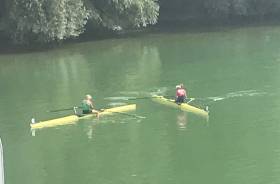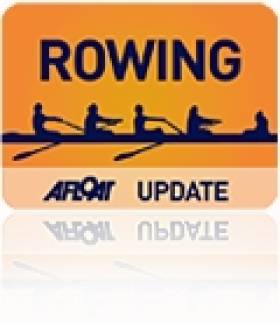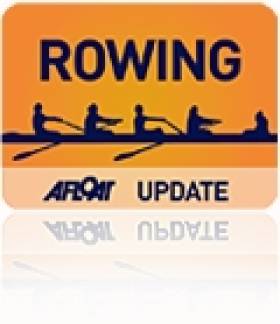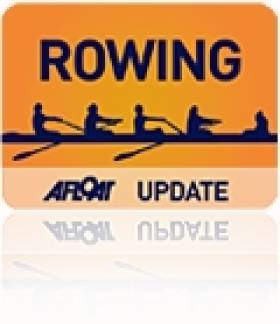Displaying items by tag: Linz
Puspure Has Huge Margin as She Wins World Championship Quarter-Final
#Rowing: Sanita Puspure won the fastest quarter-final of the women's single sculls at the World Championships yesterday - with by far the biggest margin of victory. She had more than 15 seconds to spare over the 2012 Olympic champion Mirka Topinkova Knapkova of the Czech Republic.
Puspure became the third Ireland crew to go through to semi-finals in Olympic events in this Olympic qualification regatta.
World Rowing Championships, Linz-Ottensheim, Austria, Day Four (Irish interest)
Men
Double Sculls - Quarter-Final One - (First Three to A/B Semi-Finals; rest to C/D Semi-Finals): 1 Poland 6:15.06, 2 Ireland (P Doyle, R Byrne) 6:17.78, 3 Germany 6:21.04.
Lightweight Double Sculls - Quarter-Final Three - (First Three to A/B Semi-Finals; rest to C/D Semi-Finals): 1 Ireland (F McCarthy, P O'Donovan) 6:20.84, 2 Spain 6:22.84, 3 Poland 6:23.72.
Women
Pair - Quarter-Final Two (First Three to A/B Semi-Finals; rest to C/D Semi-Finals): 1 Australia 7:08.74, 2 Ireland (A Crowley, M Dukarska) 7:12.51, 3 Italy 7:13.11.
Lightweight Double Sculls - Quarter-Final Three - (First Three to A/B Semi-Finals; rest to C/D Semi-Finals): 4 Ireland (A Casey, D Walsh) 7:07.17.
Single Sculls - Quarter-Final Four - (First Three to A/B Semi-Finals; rest to C/D Semi-Finals): 1 Ireland (S Puspure) 7:21.03, 2 Czech Republic (M Topinkova Knapkova) 7:36.19, 3 Ukraine (D Dymchenko) 7:41.48.
Pararowing: Women's PR Two Single Sculls, Preliminary Race: 1 Australia (K Ross) 9:24.99; 3 Ireland (K O'Brien) 9:52.13.
#Rowing: Monika Dukarska and Aileen Crowley kept the good buzz around Ireland performances going in Linz-Ottensheim, winning a battle with Italy to take second in the pairs quarter-final at the World Championships. The Australian pair of Jessica Morrison and Annabelle McIntyre opened an early lead and won by a big margin. Italy and Ireland moved into clear second and third spots, but it took a fight-out coming up to the line to decide it. All three crews qualified for the semi-finals, but Ireland looked steady and strong and finished out well to secure a better lane draw.
World Rowing Championships, Linz-Ottensheim, Austria, Day Four (Irish interest)
Women
Pair - Quarter-Final Two (First Three to A/B Semi-Finals; rest to C/D Semi-Finals): 1 Australia 7:08.74, 2 Ireland (A Crowley, M Dukarska) 7:12.51, 3 Italy 7:13.11.
Pararowing: Women's PR Two Single Sculls, Preliminary Race: 1 Australia (K Ross) 9:24.99; 3 Ireland (K O'Brien) 9:52.13.
Fine Start at World Championships by Katie O'Brien
#Rowing: Katie O'Brien took a fine third place in her first race of the World Rowing Championships. The Galway woman's contest came in a preliminary round - but it was a notable contest, as Kathryn Ross of Australia won in a new world's best time of nine minutes 24.99. Behind her Annika van Der Meer of Netherlands fought it out with O'Brien, who finished well to the cheers of the Irish crowd in the grandstand.
World Rowing Championships, Day Four (Irish interest)
Women's PR Two Single Sculls, Preliminary Race: 1 Australia (K Ross) 9:24.99; 3 Ireland (K O'Brien) 9:52.13.
#WorldUnder-23Rowing: The Ireland heavyweight four finished third in their B Final, ninth overall, at the World Under-23 Championships in Linz in Austria this morning. Croatia won the race and Lithuania, after duelling with Ireland in the middle stages, secured second. The Ireland crew of Richie Bennett, Matthew Wray, John Mithcell and Rob O’Callaghan held off Norway for third. Britain withdrew as they had to call on one of the members of the crew for their quadruple scull.
Adam Boreham, the reserve for the men's heavyweight crews, finished sixth in the D Final of the men's single sculls, 24th overall.
World Under-23 Rowing Championships, Linz, Austria, Day Four (Irish interest, selected results)
Men
Four – B Final (places 7 to 11): 1 Croatia 6:14.55, 2 Lithuania 6:17.00, 3 Ireland (R Bennett, M Wray, J Mitchell, R O’Callaghan) 6: 19.24, 4 Norway 6:19.29. Britain did not start.
Pair - (First Three to A Final; rest to B Final) – Semi-Final One: 1 South Africa (D Hunt, V Breet) 6:46.15, 2 Greece (K Christomanos, A Dafnis) 6:49.16, 3 Serbia (M Vasic, R Deric) 6:49.47; 4 Hungary 6:50.31, 5 Ireland (S O’Connor, F McQuillan-Tolan) 6:59.77, 6 Lithuania 7:20.32.
Lightweight Double Sculls – (First Three to A Final; rest to B Final) – Semi-Final One: 1 Germany (M Moos, J Osborne) 6:36.55, 2 Italy (L Barbaro, S Molteni) 6:37.75, 3 Spain (J de Haz, J Zabala Artetxe) 6:37.88; 4 Poland 6:38.49, 5 Ireland (S O’Driscoll, G O’Donovan) 6:46.30, 6 Norway 6:48.13.
Lightweight Single Sculls – (First Three to A Final; rest to B Final) – Semi-Final One: 1 United States (A Campbell) 7:11.15, 2 Ireland (P O’Donovan) 7:12.58, 3 Britain (Z Lee-Green) 7:14.26; 4 Australia 7:22.67, 5 Italy 7:24.34, 6 Germany 7:28.69.
Single Sculls - D Final (places 19 to 24): 6 Ireland (A Boreham) 7:36.40.
Women
Lightweight Single Sculls – (First Three to A Final; rest to B Final) – Semi-Finals Two: 1 Greece (A Nikolaidou) 7:54.92, 2 Austria (A Berger) 8:00.22, 3 Ireland (D Walsh) 8:00.28; 4 France 8:04.30, 5 Germany 8:11.25, 6 Cyprus 8:11.63.
#WorldUnder-23Rowing: The Ireland women’s four secured the first A Final place for Ireland at the World Under-23 Rowing Regatta at Linz in Austria today. The crew of Emily Tormey, Ailish Sheehan, Aifric Keogh and Lisa Dilleen needed to finish in the top two of their repechage to get through, and by the closing stages Ireland and Poland were on their way to those places. However, Ireland beat Poland into second to improve their lane draw in the final.
The Ireland men's four of Richie Bennett, Matthew Wray, Jonathan Mitchell and Rob O'Callaghan will row in a B Final. They finished fifth in their repechage.
World Under-23 Rowing Championships, Day Two (Irish interest, selected results)
Men
Four – Repechage One (First Two to A Final; rest to B Final): 1 Germany 6:01.85, 2 Italy 6:03.35; 3 Croatia 6:05.59, 4 Norway 6:11.03, 5 Ireland (R Bennett, M Wray, J Mitchell, R O’Callaghan) 6:16.97.
Pair – (First Two Directly to A/B Semi-Finals; rest to Repechage) – Heat Two: 1 Australia (A Moore, A Hill) 6:37.37, 2 Ireland (S O’Connor, F McQuillan-Tolan) 6:49.15; 3 Russia 6:54.42, 4 Venezuela 7:05.10, 5 United States 7:09.48, 6 Estonia 7:15.64.
Lightweight Double Sculls – (First Two Directly to A/B Semi-Finals; rest to Repechage) – Heat Three: 1 France (D Piqueras, D Houin) 6:26.65, 2 Italy (L Barbaro, S Molteni) 6:31.96; 3 Ireland (S O’Driscoll, G O’Donovan) 6:37.40, 4 Russia 6:42.81, 5 Lithuania 7:05.01.
Women
Four – Repechage One (First Two to A Final; rest to B Final): 1 Ireland (E Tormey, A Sheehan, A Keogh, L Dilleen) 6:48.03, 2 Poland (A Budzynska, J Dittmann, M Cylwik, O Michalkiewicz) 6:48.59; 3 United States 6:54.09, 4 Italy 6:55.92, 5 France 6:58.66.
Lightweight Single Sculls – (First Two Directly to A/B Semi-Finals; rest to Repechage) – Heat One: 1 Belgium (E Peleman) 7:46.06, 2 Ireland (D Walsh) 7:50.87; 3 Croatia 7:52.54, 4 Germany 8:00.47, 5 Israel 8:04.22, 6 Argentina 8:06.23.
#WorldUnder-23Rowing: Ireland’s Shane O’Driscoll and Gary O’Donovan finished third in their heat of the lightweight double sculls this morning at the World Under-23 Rowing Championships in Linz in Austria. France set the winning pace and Italy followed them into the second direct qualification place for the semi-finals. O’Driscoll and O’Donovan did not have the required fast first quarter, and despite competing hard in the middle stages the qualification place eluded them. They are now set for the repechages.
World Under-23 Rowing Championships, Day Two (Irish interest, selected results)
Men
Pair – (First Two Directly to A/B Semi-Finals; rest to Repechage) – Heat Two: 1 Australia (A Moore, A Hill) 6:37.37, 2 Ireland (S O’Connor, F McQuillan-Tolan) 6:49.15; 3 Russia 6:54.42, 4 Venezuela 7:05.10, 5 United States 7:09.48, 6 Estonia 7:15.64.
Lightweight Double Sculls – (First Two Directly to A/B Semi-Finals; rest to Repechage) – Heat Three: 1 France (D Piqueras, D Houin) 6:26.65, 2 Italy (L Barbaro, S Molteni) 6:31.96; 3 Ireland (S O’Driscoll, G O’Donovan) 6:37.40, 4 Russia 6:42.81, 5 Lithuania 7:05.01.
Women
Lightweight Single Sculls – (First Two Directly to A/B Semi-Finals; rest to Repechage) – Heat One: 1 Belgium (E Peleman) 7:46.06, 2 Ireland (D Walsh) 7:50.87; 3 Croatia 7:52.54, 4 Germany 8:00.47, 5 Israel 8:04.22, 6 Argentina 8:06.23.


































































